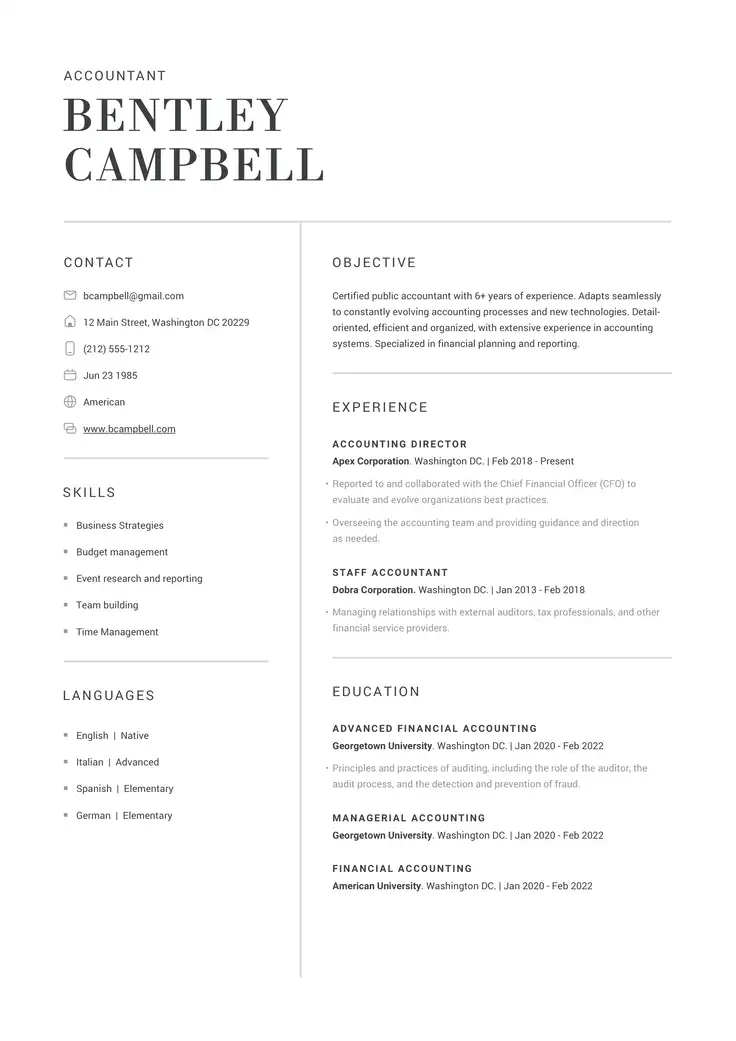Are you considering a career change, whether to move from one position to another or enter a different sector?
It’s not always easy to make the leap, especially if you’re an entry-level candidate with no experience in the field. However, your resume can make an impact if you add the right transferable skills.
Adding transferable skills to your resume and showcasing them to potential employers can significantly improve your chances of reaching the first interview stage.
In this article, we’ll go over:
- Why transferable skills are important in today’s job market
- How to show transferable skills on a resume
- Who should add transferable skills to their resume
- Examples of transferable skills
- Where to include transferable skills in your resume
Along with this info, you can also use our AI skills generator to quickly add relevant transferable skills throughout your application.
With our tips and building tools, you can stand out to employers even if you don’t have experience in the role you want.
What Are Transferable Skills?
Transferable skills are abilities and competencies that can be applied across various roles and industries. They are those skills that you have used in one role and which can be applied to the next one, too, even if the jobs are different.
If you have developed communication skills by assisting customers in a sales assistant role at a store, you can transfer this skill to a new role in customer service at an e-commerce company.
It’s essential to identify which skills the employer is looking for and clearly demonstrate them on your resume. You then need to tailor your resume for each job you apply for by focusing on the key job requirements for each position.
By strategically weaving transferable skills into a resume, candidates can ensure they are highlighted in various contexts, making them more noticeable to recruiters and hiring managers.
Why You Should Add Transferable Skills to Your Resume
There are some new trends in recruitment that emphasize the importance of reviewing transferable skills on a resume.
These trends are, in part, driven by the growing skills gap being experienced by most companies.
Increasing emphasis on transferable skills
Recent figures reported by the World Economic Forum show that 87% of companies worldwide now or expect to experience skills gaps, which is making transferable skills increasingly vital.
Employers want a versatile and adaptable workforce that can keep up with changing job roles and industries.
That’s why skills-based hiring is becoming more prevalent, with companies focusing on the skills candidates bring rather than their previous job titles or specific industry experience. In fact, 75% of recruiting professionals predict that skills-first hiring will be a priority in the next 18 months.
Reduced training time and improved retention
Hiring candidates with strong transferable skills can reduce the time and resources needed for training. These candidates can quickly adapt to their new roles, leading to improved retention rates and overall job satisfaction.
This is really important in industries facing talent shortages and high turnover rates.
Who Should Include Transferable Skills on Their Resume
Here are some examples of job seekers who should emphasize their transferable skills:
- Career changers: Transferable skills can help bridge the gap between your previous jobs and the new field.
- Recent graduates: With limited work experience, graduates should leverage transferable skills gained through cooperative experiences, internships, volunteer work, or academic projects. Recent graduates should start by reviewing their experiences to identify skills that are attractive to employers. Skills such as project management, communication, problem-solving, teamwork, and adaptability are highly transferable and widely sought-after by employers across many industries.
-
💡 Our expert’s advice

A skills-based resume format can be particularly effective for entry-level candidates. This format emphasizes skills and relevant experiences over chronological work history, making it easier to highlight transferable skills.
- Professionals seeking promotions: When aiming for a higher-level position, you might need to demonstrate different qualifications that show potential for growth.
- Individuals with employment gaps: If you have a gap in your resume, you can use transferable skills to highlight your continued relevance in the job market. You can, for example, use transferable skills to highlight your continued relevance in the job market by including volunteer work experience or relevant coursework to keep your skills up to date.
If you have experience in the role you’re shooting for, you probably won’t need to add any transferable skills unless the role is slightly different or within a different sector. In this case, you may need to add something to your resume that shows you can adapt to the role within a new context.
Transferable Skills List
It’s a great idea to go over transferable skills that fit across a number of industries and positions to make sure you add qualities that will shine no matter what job you are transitioning to. Below, you can go over the following list of soft skills and hard skills:
Communication skills
- Public speaking and giving presentations
- Written communication
- Listening skills
- Slack
- Google Workspace
- Giving instructions to others
Problem-solving
- Using mathematics to solve problems
- Using critical thinking to make decisions and solve problems
- Conflict resolution
- Event or project planning
- Preventing problems from occurring or recurring
Organizational skills
- Time management
- Meeting deadlines
- Allocating resources
- Coordinating workloads
- Using organizational software such as shared calendars, project management systems (JIRA, Asana, or Trello), spreadsheets, and databases
Interpersonal skills
- Motivating others
- Providing constructive feedback
- Negotiating
- Building customer relationships
- Influencing others
Management skills
- Supervising employees
- Overseeing budgets
- Recruiting staff
- Giving training
- Producing reports
Computer and Technical Skills
- Using software related to your job
- Installing software on computers
- Troubleshooting problems with hardware or software
- Using basic programs such as email and spreadsheets
- Using AI chatbots (ChatGPT, Gemini) to come up with solutions
How to Highlight Your Transferable Skills
Now that you have seen why they are important and what they are, we are going to examine how to highlight your transferable skills at each step of the job search process.
Transferable skills on a resume
You may be wondering, “What resume sections are best for highlighting transferable skills?”
Transferable skills should be distributed throughout the resume to maximize their impact. This includes incorporating them into the:
- Professional summary
- Skills or qualifications section
- Employment experience section
Follow the tips below to make sure your skills appear correctly to impress the hiring manager.
Resume summary
Your resume summary is typically the first section that is seen by recruiters and hiring managers.
This might be your first chance to showcase a transferable skill or two! Include concrete examples that show how the specific transferable skills that you mention have solved problems and made an impact—and how they can make an impact in your new role
Here’s an example of how you can mention transferable skills in a professional summary:
Summary
Versatile professional with 5+ years in project management, aiming to transition to Product Manager. Excelled in team leadership, operational efficiency, and strategic implementation, evidenced by leading cross-functional teams to 20% market share growth and reducing project delivery times by 25%. Adept at leveraging analytical skills to solve complex issues, contributing to a 30% increase in team efficiency. Aspires to apply project management expertise and data-driven decision-making to enhance product development and market positioning.
This candidate has demonstrated transferable skills in leading teams, time management, data analysis, decision-making, and problem-solving. All skills which applied to their past role and are also relevant to the one they are aiming for.
Skills Section
Your skills section is, of course, the main area of your resume where you can list your transferable skills. You can separate your skills into bulleted lists detailing technical, hard, and soft skills.
For resumes without extensive experience, you might place your skills section at or near the top of your resume to catch the eye of a recruiter or hiring manager.
Experience section
The Experience section of your resume allows you to demonstrate how you applied some of your transferable skills to your everyday tasks and responsibilities.
So, rather than simply stating that you “Handled customer inquiries and solved customer issues” and “Met call-per-hour requirements,” you might add details to showcase your skill set.
Employ the PAR method to describe your experience. Detail skills with Problem, Action, and Result (PAR) across your resume.
Experience
Customer Service Representative
11/2022 – Present
The Best Company | Huntington, NY
• Established positive relationships with customers, leading to a 15% increase in customer retention.
• Resolved customer issues and assisted in troubleshooting, resulting in a 98% customer satisfaction rating.
• Exceeded call-per-hour goals by two calls per hour on average, successfully resolving customer inquiries in 4.4 minutes, less than the goal of 5.8 minutes per call.
Here, you have clearly demonstrated communication, problem-solving, and time-management skills that show employers that you not only possess these abilities but are able to apply them in work environments.
💡Tip
Use our AI resume builder to generate relevant skills throughout your resume quickly.
Education section
Finally, the Education section is another place on your resume where you can mention the abilities you learned at college or in school that can be applied to a work setting.
Here’s an example of how an entry-level candidate can show transferable skills:
Education
Bachelor of Science in Business Administration, 2024
Top University, New York, NY
Relevant Coursework:
• Human Resources Management: Acquired skills in planning, employee relations, decision-making, conflict management, and organization through projects, role-playing, and research papers.
• Marketing Management: Built skills in areas of customer relationship development, market analysis, public relations, and planning.
• Public Speaking: Developed strong oral and written communication skills through class presentations, reports, and group projects.
Transferable skills in a cover letter
Similar to when you tailor your resume when writing a cover letter, you should take the qualifications listed in a job posting and match them with your skills and experience.
Add examples of work achievements, projects, or training. Add measurable results when possible.
In my role as a sales rep, I made 10+ cold calls per day and met with various prospects, which taught me to employ strong communication and relationship-building skills that I applied to a diverse audience. My success in these areas drove revenue up 15% during my two years of employment. These are skills that I can immediately apply to the role of sales coordinator that you are currently offering.
Mention transferable skills in your job interviews
Before an interview, it’s best to research the company and also to review once more the qualifications listed in the job posting and the resume you submitted.
To ensure that you’re fully prepared to ace your interview, you might practice answering some scenario-based interview questions that allow you to expand on how you used transferable skills in the past.
Take some of your top transferable skills and come up with details about how you used them in specific situations.
For example, time management could be one of your top skills. Devise an answer around a question like this one:
Describe a time when you had to meet a deadline.
Describe the context, the action you took, and the favorable result.
I was once assigned a critical project where the client asked for a report within one week. I immediately assembled a team, delegated tasks to those who displayed the best abilities to carry them out and kept in constant communication with team members through emails and daily meetings. By regularly reviewing the project’s progress, setting clear goals, and working only two extended days, we were able to meet the client’s deadline efficiently and effectively.
Add, too, how you can apply that transferable skill to your new position.
I can easily adapt to meet deadlines of any project and maintain focus through goal-setting and constant team communication to ensure that client needs are met at all times.
Key Points
No matter what stage of your professional journey you’re in, changing careers has its ups and downs. However, with the right templates and tools, you can quickly slot in your transferable skills to impress recruiters in your new field.
Also, by applying the advice we’ve mentioned, you’ll make crafting your resume much easier, such as the following:
- Add transferable skills throughout your skills, experience, and summary sections
- Mention achievements and how those skills helped you
- Review the job description thoroughly and use industry-specific keywords
- Use the PAR method to list your experience
Beyond your resume, you can apply our strategies for your cover letter and during your interview to keep those transferable skills at the forefront as you move through your job search process.
If you follow these tips when applying for a new role, you’ll be preparing for your first interview in no time.
Related Posts





